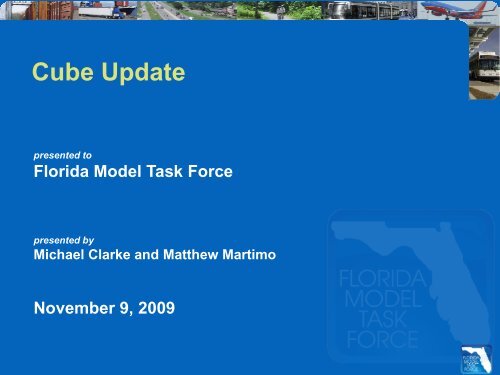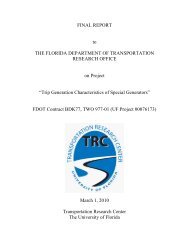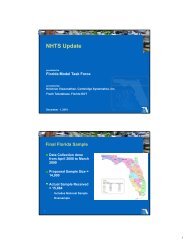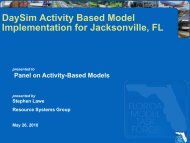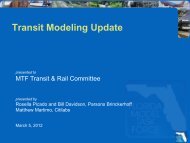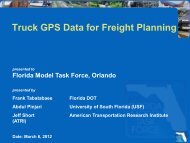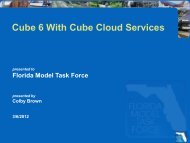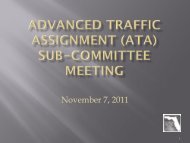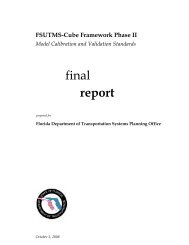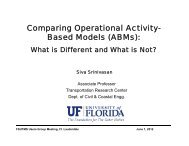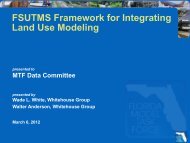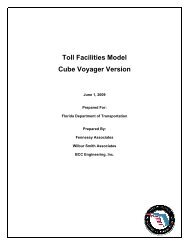Citilabs Voyager Update by Mike Clarke and ... - FSUTMSOnline
Citilabs Voyager Update by Mike Clarke and ... - FSUTMSOnline
Citilabs Voyager Update by Mike Clarke and ... - FSUTMSOnline
Create successful ePaper yourself
Turn your PDF publications into a flip-book with our unique Google optimized e-Paper software.
Cube <strong>Update</strong><br />
presented to<br />
Florida Model Task Force<br />
presented <strong>by</strong><br />
Michael <strong>Clarke</strong> <strong>and</strong> Matthew Martimo<br />
November 9, 2009
New Features in Cube 5<br />
New Features of Cube Base<br />
• Available<br />
• Integrated ESRI spatial functions within the model work stream<br />
(Buffer, Union, Intersect…)<br />
• Full support of ESRI-supported data formats including Bing Maps<br />
• Python Scripts as part of the Modeling Flow<br />
• Previously Released<br />
• Cube GIS Window<br />
− GIS-based network<br />
− Direct sharing of data between<br />
ESRI products <strong>and</strong> Cube<br />
− Work environment is similar to ArcGIS<br />
− On-the-fly projection<br />
• Wizard for adding user programs<br />
• Multiple model applier types
New Features in Cube 5<br />
Cube GIS<br />
Based on ArcObjects from ArcGIS<br />
Engine<br />
Provides enhanced GIS capabilities to<br />
Cube users<br />
Stores data in geodatabase format<br />
• 5.0- Personal geodatabase (MDB)<br />
• 5.1- File-based (GDB) <strong>and</strong> SDE personal<br />
<strong>and</strong> enterprise geodatabases (mySQL,<br />
SQL, Oracle …)<br />
Provides geo-processing functions<br />
based on ESRI Technology
Cube GIS Window<br />
High-Quality Mapping Using ESRI MXD Files<br />
Our Products: Cube
New Features of Cube <strong>Voyager</strong><br />
Major New Features of Cube <strong>Voyager</strong><br />
Available in 5.1:<br />
Geodatabase Read/Write updated for File-based (GDB) <strong>and</strong> SDE personal <strong>and</strong> enterprise<br />
geodatabases (mySQL, SQL, Oracle …)<br />
Multi-Dimensional Arrays<br />
New methods of highway assignment<br />
• Conjugate <strong>and</strong> Bi-Conjugate Frank-Wolfe<br />
• Gradient Projection<br />
• Stochastic<br />
Previously Released<br />
Geodatabase Read/Write – personal geodatabase (MDB)<br />
PT select link<br />
PT ‘mustusemode’ <strong>and</strong> ‘bestpathonly’ for FTA “New Starts” Analysis
Convergence of Traffic Assignments:<br />
How Much is Enough?<br />
Tampa Bay Model defaults to Relative Gap of 0.01<br />
SERPM Model defaults yield a Relative Gap of 0.005<br />
“A Relative Gap of 0.0001 is required to assure that the<br />
assignment is sufficiently converged to achieve stable link flows.”<br />
(Boyce, et al., 2004)<br />
5
Link Variance Example<br />
Chicago Sketch Network:<br />
387 zones<br />
Capacity on link<br />
492-493<br />
reduced <strong>by</strong> half<br />
(6500 to 3250)<br />
Relative Gap =0.0005<br />
= 0.001 0.0001 0.005 (SERPM Default)
Research into new methods<br />
Existing: Frank-Wolfe Algorithm
Bi-Conjugate Assignment<br />
Good Features – Provides all the Capabilities Available Today<br />
• Consistent with the existing practice including the Full<br />
functionality provided <strong>by</strong> the traditional FW assignment<br />
• Multiple user classes, Turning penalties, Junction Modeling<br />
• Select link <strong>and</strong>/or zone analysis<br />
• Distributed computing, Etc.<br />
• Maintains ‘proportionality’<br />
No need to modify anything (network, input data etc.)<br />
8
Path-based Assignment Algorithms<br />
Feasibility<br />
• The memory restriction for tracking the paths has been relaxed<br />
considerably in recent years due to rapid advances in computing<br />
environment<br />
Advantages<br />
• Fastest convergence to high accuracy<br />
• Unique Link Flow Solution<br />
Disadvantages<br />
• Does not maintain proportionality assumptions<br />
• Select Link, Select Zone not applicable<br />
• Turning Movements are not correct<br />
9
Proportionality<br />
10<br />
Regardless of the original origin <strong>and</strong> final<br />
destination, the flows over any selected set of<br />
paired segments should be consistently<br />
proportional.<br />
Critical, if you need to analyze who uses<br />
facilities – their origins <strong>and</strong> destinations<br />
(select link) or which zones contribute to the<br />
flow (select zone).<br />
Link-based methods are proportional.<br />
Origin <strong>and</strong> Path-based methods are NOT<br />
(OBA, Algorithm B, TAPAS…).<br />
Link flows <strong>and</strong> speeds are the same in both.
Proportionality <strong>by</strong> Algorithm Type<br />
11 Taken from “Practical Implications of Finding Consistent Route Flows”<br />
<strong>by</strong> Hillel Bar-Gera, et al.
Scripting the New Assignment Algorithms<br />
Conjugate <strong>and</strong> Bi-Conjugate<br />
Parameters Combine = EQUI, Enhance = #<br />
• Enhance keyword options<br />
− Frank Wolf:<br />
− Conjugate:<br />
− Bi-Conjugate:<br />
Enhance=0<br />
Enhance=1<br />
Enhance=2<br />
Path-Based Equilibrium – Select Link/Zone Disabled<br />
Parameters Combine=PATH<br />
12
New Empirical Studies<br />
Computing Platform<br />
• 64 bit Intel Platform with Vista 64<br />
• Two Xeon E5335 2GHz Quad Core Processors<br />
• 8GB of RAM<br />
Chicago Regional Network<br />
• 1790 Zones<br />
• 12982 Nodes<br />
• 39018 Links<br />
• 1360427.88 Total OD Flow<br />
13
14<br />
*The Origin-based Algorithm (OBA) adopted here is from Hillel Bar-Gera<br />
http://www.openchannelsoftware.org/projects/Origin-Based_Assignment/
SERPM 24 Hr Assignment Results
New Features of Cube Avenue<br />
New Features Available in Cube Avenue (5.1)<br />
Packet allocation<br />
Incremental time-segments allows<br />
early time segments to converge<br />
before simulating later time<br />
segments (100 Iter. to 20 Iter.)<br />
Simulation Pause <strong>and</strong> Restart<br />
These new features greatly reduce<br />
run-time <strong>and</strong> memory consumption
Key Methodologies in Cube<br />
New Activity Model Application<br />
•Script of full-activity model within Cube <strong>Voyager</strong><br />
•Based on methodology of Sacramento <strong>and</strong> SF County<br />
•Developed <strong>by</strong> Mark Bradley, Ken Vaughn <strong>and</strong> Victor Siu<br />
•Used directly for small <strong>and</strong> mid-sized urban areas<br />
•Increase segmentation in larger areas<br />
•Will be posted on the user-group web-site for download this winter
Key technologies in the ‘Labs<br />
Cube L<strong>and</strong><br />
integrated transport-l<strong>and</strong> use modeling<br />
Innovation in l<strong>and</strong> use pricing—via<br />
auction/bidding theory<br />
Evaluate impact of l<strong>and</strong> use change on<br />
transport system <strong>and</strong> transport system<br />
change on l<strong>and</strong> use<br />
Integrates directly with Cube <strong>Voyager</strong><br />
Forecasts l<strong>and</strong> rent/prices to better<br />
evaluate development pressures<br />
Forecasts households <strong>by</strong> type <strong>and</strong><br />
employment <strong>by</strong> type <strong>by</strong> TAZ
Moving to Enterprise<br />
‘Beyond Cube 5’
Moving to Enterprise<br />
What is Enterprise?<br />
• Data stored in an ESRI-compliant geo-database format<br />
• Uses market leading databases: Oracle…etc.<br />
• Able to store <strong>and</strong> manage huge amounts of data<br />
• Cube portion of the database has transportation-specific ‘rules’<br />
(topology rules) using <strong>Citilabs</strong> data model
Moving to Enterprise<br />
Why Enterprise?<br />
• Common data storage center:<br />
• You contribute your model results to the enterprise geodatabase<br />
• Others contribute their data to the enterprise geodatabase<br />
• Use data directly in the models from the database<br />
• Incorporate model results with other governmental systems<br />
(permitting…)<br />
• Take advantage of ‘future data’ in the models more easily: GPS data…
Our Products<br />
Access modeling data from three portals<br />
Cube - Desktop Professional Modeling<br />
a comprehensive suite for passenger, freight, l<strong>and</strong> use, <strong>and</strong> traffic simulation<br />
Mint - Modeling on the Internet<br />
web-based modeling platform for collaborative planning<br />
Sugar - Modeling Extensions for ArcGIS<br />
modeling <strong>and</strong> analysis tools for non-modelers
Why move modeling to the internet?<br />
Phases<br />
MPO/County Modeler<br />
Consultants<br />
MPO/County Planners<br />
Partner agencies<br />
Consultants<br />
Assign Clients with Rights<br />
MPO Director<br />
Interest Groups<br />
General Public<br />
Development Application Analysis<br />
Today<br />
Desktop<br />
Desktop<br />
Desktop<br />
Tomorrow<br />
Internet Internet Internet<br />
Priorities 3 1 2<br />
Elements<br />
• Network development<br />
• Demographics<br />
• Edit scripts<br />
• Re-organize<br />
• Add features<br />
• Entire models<br />
• Cloud-computing environment<br />
- no local high speed machines<br />
- unlimited resources<br />
- no software licensing; move<br />
to a software-as-a-service<br />
monthly subscription<br />
• Shared access to the models<br />
• Collaborative application<br />
- local agencies<br />
- federal agencies<br />
- consultants<br />
• Provide access for non-modelers<br />
• Become a ‘transportation info.<br />
system’<br />
• Use the results ‘themselves’<br />
• User friendly environment for<br />
- analysis <strong>and</strong> comparisons<br />
- mapping <strong>and</strong> charting<br />
• Ability to publish the results to<br />
‘everyone’
Primary Benefits<br />
• Internet: movement from a desktop-bound, ‘locked’ environment to an internetbased,<br />
‘open’, sharable, ‘work from anywhere/anytime’ environment<br />
• Community Resource: model application <strong>and</strong> planning analysis done <strong>by</strong> nonexperts<br />
using common web-browsers moving models to an active role in<br />
collaborative transportation planning<br />
• Cloud-Computing: placement of the models, data <strong>and</strong> software in a cloudcomputing<br />
environment lowering hardware costs locally while providing ‘unlimited’<br />
high-spec resources<br />
• Lower costs for the user: movement from locally licensed desktops to a software<br />
as a service model. Monthly subscription business model allowing many to use the<br />
model at low, or even, no cost<br />
• Lessens IT complexity: much of the IT burden of modeling is shifted from the user<br />
to the vendor<br />
• Data <strong>and</strong> Software Integration: easier to integrate with external systems:<br />
development reviews, regional air quality analysis, pavement maintenance systems,<br />
traffic <strong>and</strong> transit ITS systems <strong>and</strong> to receive <strong>and</strong> use data from data probes,<br />
detectors <strong>and</strong> static data sources
Areas in Beta Test<br />
Valley Transportation Authority, San Jose<br />
Houston, Texas MPO<br />
Minneapolis, Minnesota MPO<br />
Cincinnati, Ohio MPO<br />
City of Leesburg, Virginia<br />
Christchurch, New Zeal<strong>and</strong><br />
Brisbane, Australia<br />
Manila, Philippines<br />
Dutch Government regional models
VTA Home Page
Our Products: Sugar<br />
Sugar: Modeling Extensions for ArcGIS<br />
Available Now<br />
In Development<br />
Available Q1 2010
Sugar Example: Sugar Network Editor<br />
Our Products: Sugar
29<br />
Sugar Example: Sugar Signal
Work-Flow: Cube, Mint, Sugar
Thank you!


